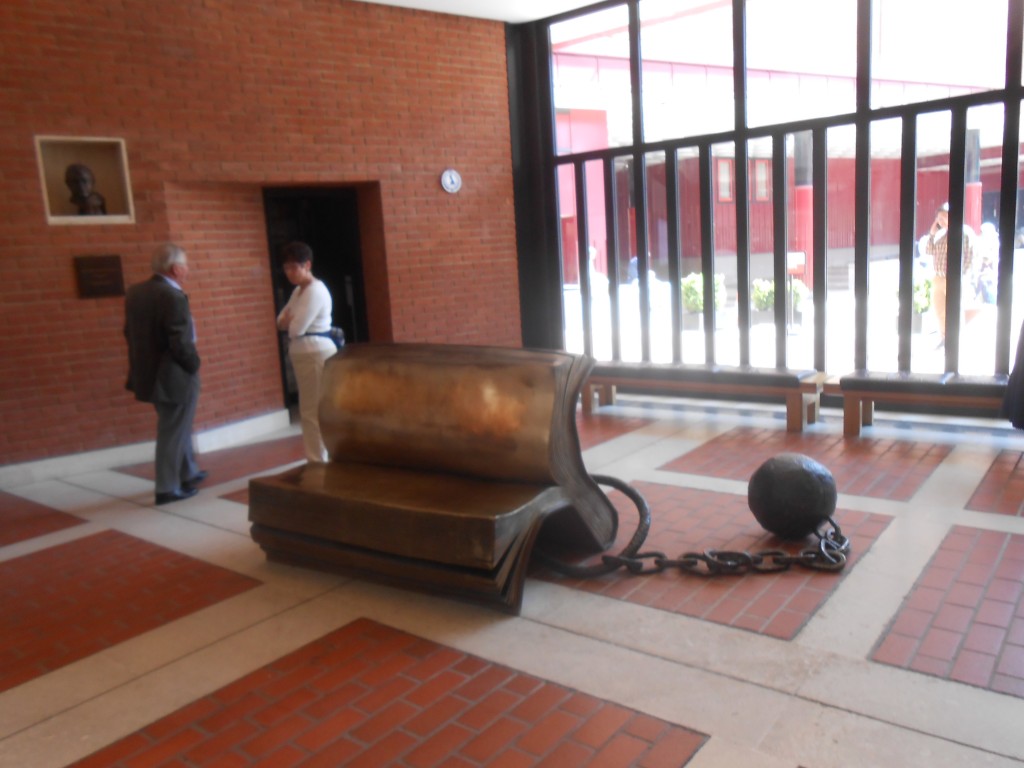I have previously stated that my imagination is stimulated by that which is not familiar but strange, the stranger the better. Accordingly, when I travel, the more unfamiliar the locale, the more it fuels my imagination. I like best to wander, soak in foreign languages, and puzzle out other peoples’ cultures. Italy has been wonderful for that. And Prague in the Czech Republic. The United Kingdom, where I spent two weeks this May, is a bit too similar to the United States in culture and language to provide quite the same effect. But, still, a number of encounters have stirred my imagination.
With a writer friend who currently is living in the U.K., I took a number of tours and traveled the country. By train, we traveled from London to Edinburgh to Dunbar to Bath to London to Brighton and back again. Sharing little adventures. Sherlock Holmes and Watson. Prince Florizel and Colonel Geraldine. Don’t ask me which of us was which. Okay. I concede. We did nothing that these characters did besides travel a great deal on trains through England and Scotland. But there is nothing like a train trip to make me live in my imagination.
In London, we took the Jack the Ripper tour, which allowed me to see some of the East End in evening, and though most of the landmark areas are now quite modern, there was one narrow alley that had kept some of the original atmosphere. However, the thing that truly caught my imagination was waiting for me back at my safe little family-run Bloomsbury hotel. The desk-man, a son of the owners, told me that, in the days of Jack the Ripper, one of the victims had lived and worked there. At the time, the hotel had been a private residence. The woman’s husband had been the butler and she the maid until her husband died and the family refused to keep her on alone. With no place to go, she gravitated to White Chapel where she was murdered soon after. To tell or retell the story of Jack the Ripper does not interest me. But to tell a story in which this woman is the main character and in which her eventual murder by Jack the Ripper is only the horrible, luckless end would be interesting. Even the few details noted here present possible themes of class, employment, the situation of women, the emotional despair that must accompany destitution, etc. Her story has pathos. And if my imagination can conjure it, my hotel provides a setting that would be interesting to use.
In Edinburgh, we toured the City of the Dead, a series of chambers under the city, where, in the late1700s, noxious businesses like tanneries were placed. We were warned not to touch the walls (or wash our hands well if we did) because we would be touching several hundred years of excrement. Meanwhile, stalactites of God-knows-what were dripping on our heads. According to our guide, the poor often both worked and lived in these chambers which are, absent flashlight or candle, pitch-black. The residents breathed in the fumes; they had to carry chamber pots through various chambers to empty them above ground; and they lived amongst illicit stills and in dark corners where murderers may have hidden bodies. I thought to myself, never mind death; they were living in Hell. Then the guide told of a great fire above ground, the smoke filtering down and killing hundreds from asphyxiation. Horrific conditions. But great atmosphere for a story of horror or mystery. And I was there to catch the mood.
In Dunbar, we visited a John Muir museum. Muir, a Scottish-born American naturalist, was an early advocate for the preservation of wilderness in the United States. We were told that he convinced Teddy Roosevelt to protect wilderness areas against corporate encroachment. But, what I found most interesting for my purposes was that Muir was in San Francisco at the same time as Robert Louis Stevenson. We were told that Muir usually tried to meet with any Scots who came his way. Yet there is no record of him meeting with Stevenson. What if one posited a story in which these two philanthropic world travelers had met? An idea to play with.
Back in London, we went to the Hunterian Museum at the Royal College of Surgeons, where I learned about John Hunter who, in the 1700s, pioneered so much of what is now established protocol in modern surgery, but who also apparently hired men to follow Charles Byrne, “The Irish Giant,” around until he should drop dead, so he–Hunter–could swoop in to obtain the body for dissection. Byrne did not want to be dissected after death, and it seems to me that even if dissection might have gained Hunter knowledge that could help mankind, your body is the one thing you should have a say about. But despite Byrne’s wishes and precautions, Hunter did manage to obtain Byrne’s body after his death (probably because of the men Hunter had ghoulishly hounding the man). It is speculated that Hunter’s residence was the model for that of Jekyl and Hyde. I would not be surprised to find that the man was Stevenson’s model for the story as well. Probably stories have already been written about the Irish Giant, but there’s something about the idea of him being tracked in anticipation of his death that intrigues me. Perhaps one could play with it from a new angle. In any case, I think I might like to try.
In sum, I can attest that, if one is open to it, travel does broaden the mind, feed the soul, and stir the imagination.

